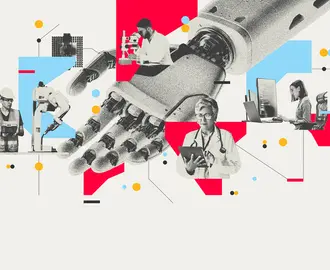Credit: Mimi Phan / gorodenkoff / iStock
Who should be the head of generative AI — and what they should do
Generative artificial intelligence has rapidly become an organizational priority. After it was launched in late 2022, ChatGPT had 100 million active users in less than two months, and many executives now consider managing AI’s impact to be a leadership priority.
But adoption takes time and requires proper stewardship. In a recent webinar hosted by MIT Sloan Management Review, London Business School professor Lynda Gratton discussed the new roles companies are creating to guide AI initiatives, the job responsibilities of these leaders, and how companies can use AI for people management.
Introducing the “head of generative AI”
Many companies are introducing positions to guide generative AI use. Last year, Coca-Cola moved Pratik Thakar from his role as head of global creative strategy to senior director of generative AI. Likewise, advertising agency M&C Saatchi named chief data strategy officer James Calvert its new head of generative AI, Gratton noted.
She pinpointed five key job responsibilities for those in these new roles:
- Steering the strategic direction and alignment of AI work.
- Establishing and sustaining a collaborative generative AI ecosystem.
- Monitoring and evaluating generative AI experiments to inform best practices.
- Identifying high-impact use cases for scalability.
- Overseeing generative AI integration across business units.
Some generative AI leaders might have a creative background; others could come from tech. Gratton said background matters less than a willingness to experiment.
“You want somebody who’s got an experimental mindset, who sees this as a learning opportunity and sees it as an organizational structuring issue,” she said. “The innovation part is what’s really crucial.”
Ways to use AI for people management
The head of AI could encourage use of the technology to help with managing employees, Gratton said. This encompasses three key areas:
Talent development. Companies can use chatbots and other tools to recruit people and help them manage their careers.
Productivity. AI can be used to create assessments, give feedback, manage collaboration, and provide skills training.
Change management. This includes both internal and external knowledge management. “We have so much knowledge in our organizations … but we don’t know how to find it,” Gratton said. “And it seems to me that this is an area that we’re really focusing on in terms of generative AI.”
Trust, collaboration, and open-mindedness are essential
As companies embark on their generative AI journeys and add leadership in this area, transparency is key.
Related Articles
“Employees need to feel that they trust their managers,” Gratton said. “This isn’t just a piece about technology; it’s also a piece about how you manage change.”
Some workers fear that AI could replace them. A good leader will address those concerns and generate companywide enthusiasm across roles and age groups.
“The CEO and the leadership team have got to set a narrative. When you have high levels of ambiguity, the job of a leader is to tell stories about the future, to help people think: ‘This is where we’re walking; this is why it’s happening; this is how we feel about it,’” she said. This includes getting everyone in the organization involved in thinking about how to use generative AI.
Leaders should remember that buy-in across all career stages and skill levels is essential. Generative AI isn’t just the domain of youth.
“We shouldn’t stereotype the idea that it’s only young people who are thinking about this. In fact, if you look at people at every stage in their working life, they are very interested — and there’s even some data that show the over-50s are really working to experiment and to understand generative AI,” Gratton said. “Don’t be blinkered about what you expect your employees to do.”
Watch the full webinar: What AI Means for Human Capital



